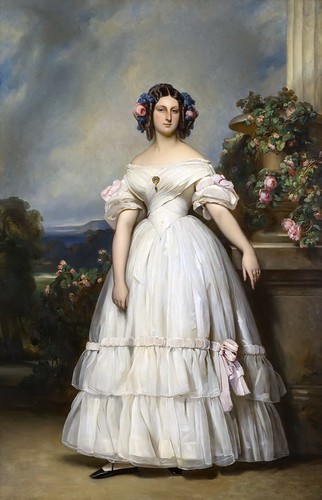
PREV ARTICLE
NEXT ARTICLE
FULL ISSUE
PREV FULL ISSUE
CLEMENTINE D'ORLEANS: FEMALE NUMISMATISTKünker recently released this article on female coin collector Clémentine d'Orléans. Her collection will be sold as part of the estate of Dr. Alexander Eugen Duke of Württemberg, the final part of which will be sold in Künker's upcoming Auction 415 on 28 October 2024. -Garrett On 3 June 1817, Maria Amalia of Naples and Sicily, wife of Louis Philippe, Duke of Orléans, gave birth to her sixth of what would eventually be ten children: a daughter, elaborately christened Marie Clémentine Léopoldine Caroline Clotilde. At the time of her birth, Louis Philippe was far from a contender for the throne. He was serving as general in the French army and was a loyal supporter of the recently restored Bourbons Louis XVIII and Charles X. There may have been a slight uneasiness, however, as Louis Philippe's father – an enthusiastic supporter of the Enlightenment – had supported the French Revolution under the name Philippe égalité. Although, like many others, he had died on the guillotine during the Reign of Terror, he had raised his son according to the ideals of a new, enlightened and economically strong bourgeoisie. Maybe this is what gave Louis Philippe his uncanny ability to read the signs of the times. He traveled to England and the United States and had discussions with (for that time) progressive politicians like George Washington and Alexander Hamilton. At the same time, though, he also maintained strong ties to important banking houses such as Rothschild and Laffitte. Louis Philippe perfectly knew how to handle money, including his own. He used the most modern investment methods to expand the already enormous family fortune. Even before his accession to the throne, Louis Philippe was one of the wealthiest men in France. As early as 1821, his fortune was estimated at around 8 million francs – and it was to increase considerably. A Modern Upbringing for the Children Louis Philippe also shared the upbringing ideals of the French bourgeoisie. The fact that family life should be loving and involve plenty of contact between parents and children was a given for him. Clémentine – or Titine, as she was affectionately called by her siblings – experienced an almost normal upbringing. They dined and celebrated as a family; they traveled together to the countryside, where Titine and her siblings gallivanted in parks and swam in ponds. Naturally, each of the children also received an excellent education. For the girls, this meant a troupe of governesses and tutors who taught them embroidery and dancing, etiquette and conversation, and, of course, the mastery of a musical instrument (the harp, in Clémentine's case) that was inevitably expected of every little girl. The syllabus was rounded off by various languages as well as religious education personally provided by Maman. The father was also involved in educating his children. He had some experience, after all, having taught French to make ends meet during his years of exile. Louis Philippe taught his children history and geography using memorabilia from the family estate. Clémentine completed her education by embarking on the Grand Tour, which was more usual for young men at the time. She journeyed to the mountains of Switzerland and beheld the wonders of Italy. Whether Clémentine had already begun to take an interest in coins at this time cannot be known for sure. But we do know that she was not the only family member interested in numismatics. Among her close relatives were several prominent collectors. The most well-known of these today is Henri, Duke of Aumale, who assembled such an extensive collection of paintings and art objects that his coin collection tends to be forgotten. Clémentine's eldest son Philipp was also an ambitious numismatist. He published works on oriental numismatics, and his collection was auctioned off by the Leo Hamburger auction house in Frankfurt in 1928. Although, in the 19th century, it was widely considered good form for an educated man to collect at least a few coins, this was not really the case for women. And the reason for this probably was not even a lack of interest: most women just did not have the necessary financial means to purchase coins. But this was not the case for Clémentine. She had one of the largest fortunes in Europe.
To read the complete article, see:
Wayne Homren, Editor The Numismatic Bibliomania Society is a non-profit organization promoting numismatic literature. See our web site at coinbooks.org. To submit items for publication in The E-Sylum, write to the Editor at this address: whomren@gmail.com To subscribe go to: https://my.binhost.com/lists/listinfo/esylum All Rights Reserved. NBS Home Page Contact the NBS webmaster 
|


